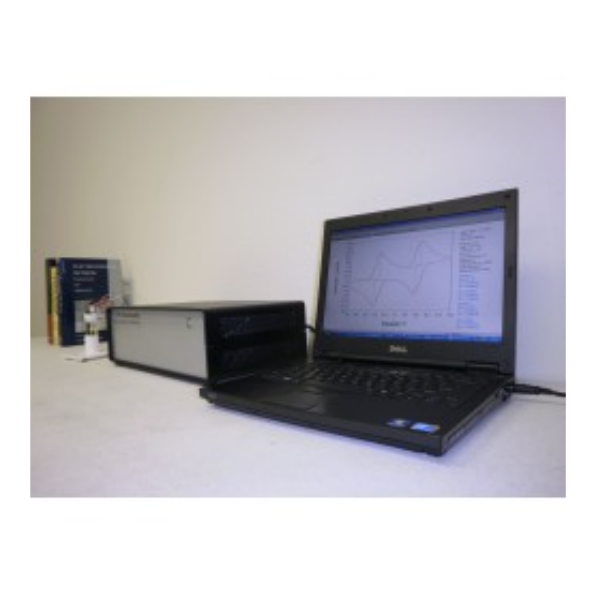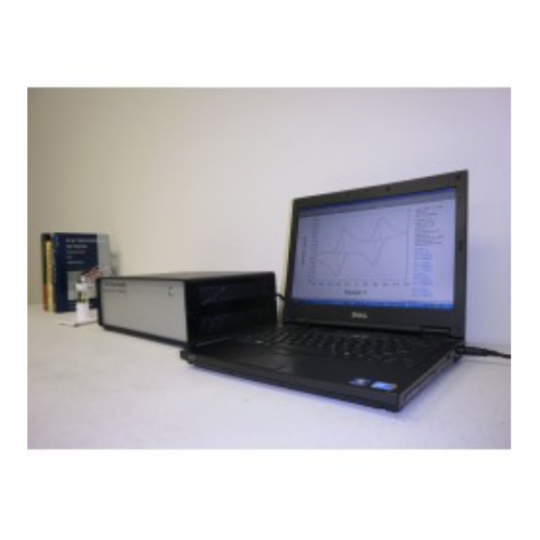Opis
The Model 1100D series power potentiostat/galvanostat is designed for electrochemical applications that require relatively large current and high compliance voltage, such as battery studies, corrosion, electrolysis, and electroplating. The potential control range is ±10 V, the current range is ±2 A, and the compliance voltage is ±25 V. The instrument contains a high speed digital function generator, a fast data acquisition system, current signal filters, iR compensation circuitry, a potentiostat, and a galvanostat (1140D only). The function generator can update at a 10 MHz rate, and the maximum sampling rate is 1 MHz at 16-bit resolution. The 1100D series is capable of measuring current down to tens of picoamperes. The steady state current of a 10 μm disk electrode can be readily measured without external adapters. The instrument provides a very wide dynamic range of experimental time scales. For instance, the scan rate in cyclic voltammetry can be up to 1000 V/s with a 0.1 mV potential increment, or 5000 V/s with a 1 mV potential increment. The potentiostat/galvanostat uses a 4-electrode configuration, allowing it to be used for liquid/liquid interface measurements and eliminating the effect of the contact resistance of connectors and relays for high current measurements. The data acquisition systems allow an external input signal (such as spectroscopic) to be recorded simultaneously with electrochemical data.
The model 1100D series is the latest upgrade to our model 1100 series. The major improvement is very stable and accurate potential control.
The 1100D series has a USB port (default) and a serial port for data communication with the PC. You can select either USB or serial (but not both) by changing a switch setting on the rear panel of the instrument.
16-bit highly stable bias circuitry has been added for current or potential bias. This allows wider dynamic range in AC measurements. It can also be used to re-zero the DC current output.
We provide several different models in the 1100D series. The following table compares the different models. Other than what is listed, the specifications and features of these models are identical. Models 1100D/1110D are basic models, while Model 1140D is a more advanced model with a galvanostat.
Model 1100D Series Specifications
Potentiostat
Galvanostat (1140D only)
Potential range: -10 to 10 V
Applied potential resolution: 0.0015% of potential range
Applied potential accuracy: ±2 mV, ±0.02% of scale
Potentiostat rise time: < 2 μs
Compliance voltage: ± 25 V
3- or 4-electrode configuration
Current range: ± 2 A
Reference electrode input impedance: 1×1012 ohm
Sensitivity scale: 1×10-12 – 0.1 A/V in 12 ranges
Input bias current: < 50 pA
Current measurement resolution: < 1 pA
Potential update rate: 10 MHz
Data acquisition: 16-bit @ 1 MHz
External voltage signal recording channel
External potential input
Automatic and manual iR compensation
Potential and current analog output
RDE control voltage output: 0-10V (1130D and up)
CV and LSV scan rate: 0.000001 to 5000 V/s
Potential increment during scan: 0.1 mV @ 1000 V/s
CA and CC pulse width: 0.0001 to 1000 s
CA and CC Steps: 320
DPV and NPV pulse width: 0.001 to 10 s
SWV frequency: 1 to 100 kHz
CA and i-t sample interval: minimum 1 μs
ACV frequency: 0.1 Hz to 10 kHz
SHACV frequency: 0.1 Hz to 5 kHz
Automatic potential and current zeroing
Signal low-pass filters, covering 8-decade frequency range, Automatic and manual setting
Potential and current analog output
Cell control: purge, stir, knock
Current low-pass filters, covering 8-decade frequency range, Automatic and manual setting
Flash memory for quick software update
USB or serial port selectable for data communication
Maximum data length: 128K-4096K selectable
Chassis dimensions: 14.25”(W) x 9.25 ”(D) x 4.75”(H)
Weight: 17 lb.
Model Comparison
| Functions | 1100D | 1110D | 1120D | 1130D | 1140D | |
|---|---|---|---|---|---|---|
| Cyclic Voltammetry (CV) | ● | ● | ● | ● | ● | |
| Linear Sweep Voltammetry (LSV) & | ● | ● | ● | ● | ● | |
| Staircase Voltammetry (SCV) #,& | ● | ● | ||||
| Tafel Plot (TAFEL) | ● | ● | ||||
| Chronoamperometry (CA) | ● | ● | ● | ● | ||
| Chronocoulometry (CC) | ● | ● | ● | ● | ||
| Differential Pulse Voltammetry (DPV) #,& | ● | ● | ● | ● | ||
| Normal Pulse Voltammetry (NPV) #,& | ● | ● | ● | ● | ||
| Differential Normal Pulse Voltammetry (DNPV)#,& | ● | |||||
| Square Wave Voltammetry (SWV) & | ● | ● | ● | |||
| AC Voltammetry (ACV) #,&,$ | ● | ● | ||||
| 2nd Harmonic AC Voltammetry (SHACV) #,&,$ | ● | ● | ||||
| Amperometric i-t Curve (i-t) | ● | ● | ||||
| Differential Pulse Amperometry (DPA) | ● | |||||
| Double Differential Pulse Amperometry (DDPA) | ● | |||||
| Triple Pulse Amperometry (TPA) | ● | |||||
| Bulk Electrolysis with Coulometry (BE) | ● | ● | ● | ● | ||
| Sweep-Step Functions (SSF) | ● | |||||
| Multi-Potential Steps (STEP) | ● | |||||
| Chronopotentiometry (CP) | ● | |||||
| Chronopotentiometry with Current Ramp (CPCR) | ● | |||||
| Multi-Current Steps (ISTEP) | ● | |||||
| Potentiometric Stripping Analysis (PSA) | ● | |||||
| Open Circuit Potential – Time (OCPT) | ● | ● | ● | ● | ● | |
| Galvanostat | ● | |||||
| RDE control (0-10V output) | ● | |||||
| CV simulation program | ○ | ○ | ○ | ● | ● | |
| iR Compensation | ● | ● | ● | ● | ● | |
| External Potential Input | ● | ● | ● | ● | ● | |
| Auxiliary Signal Measurement Channel | ● | ● | ● | ● | ● | |
#: Corresponding polarographic mode can be performed.
&: Corresponding stripping mode can be performed.
○: Limited version


